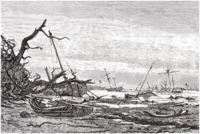1872 Baltic Sea flood

The 1872 Baltic Sea flood (German: Ostseesturmhochwasser 1872), often referred to as a storm flood, ravaged the Baltic Sea coast from Denmark to Pomerania in the night of 12/13 November 1872 and was, until then, the worst storm surge in the Baltic. The highest recorded peak water level was about 3.3 m above sea level (NN).
Course
In the days before the storm tide, a storm blew from the southwest across the Baltic that drove the sea towards Finland and Balticum. The result was flooding there and extreme low water levels on the Danish-German coastlines. As a result, large quantities of water were able to flow into the western Baltic from the North Sea. Suddenly the storm, which had now increased in strength to become a hurricane changed direction, blowing from the northeast, and drove the water masses back in a south-westerly direction. Because the water could only flow slowly back into the North Sea, huge waves caught coastal dwellers by surprise on the morning of 13 November 1872 and caused floods over a metre high in coastal towns and villages.
Short-term impact
Of all the German coastal settlements, Eckernförde was most heavily damaged due to its location on the Bay of Eckernförde which was wide open to the northeast. The entire town was flooded, 78 houses were destroyed, 138 damaged and 112 families became homeless. In Mecklenburg and West Pomerania 32 people lost their lives on land due to the floods. The Danish island of Lolland, which still has areas enclosed by dykes today that lie below sea level, was badly hit. In the Greifswald village of Wieck almost all the buildings were destroyed and nine people drowned. Houses were rubbled as far as the centre of Greifswald. Peenemünde was completely swamped. On Falster 52 died; on Lolland 28.
In all the flood cost the lives of at least 271 people on the Baltic Sea coast; 2,850 houses were destroyed or at least badly damaged and 15,160 people left homeless as a result.
Long-term impact
As a result of this disaster, which also flooded large parts of Prerow on the Darß, the Prerower Strom, which had hitherto separated the island of Zingst from Darß, silted up. In 1874, the Prerow-Strom was finally filled in and protected with a dyke; Zingst thus became a peninsula.
The Koserower Damerow was destroyed and the island of Usedom near Koserow split in two. Following a further flood in February 1874, in which the remains of the buildings were destroyed and a layer of sand up to 60 cm thick left behind, Damerow was abandoned.
Classification
This flood counts statistically as a 100-year flood. A storm flood of similar dimensions today would cause far more damage because the coastal region is much more densely populated than at that time.
Individual high water marks
-

High-water marks
in Dahme/Baltic Sea -

High-water mark
on the old
Travemünde Lighthouse -

High-water mark
Maasholm (Schlei) harbour -

High-water marks
from 1625 and 1872
Travemünde
Alte Vogtei
Further reading
- Heinz Kiecksee, P. Thran, H. Kruhl: Die Ostseesturmflut 1872. Boyens, Heide 1984, ISBN 3-8042-0116-4 (Schriften des Deutschen Schiffahrtsmuseums; 2).
- Marcus Petersen, Hans Rohde: Sturmflut. Die großen Fluten an den Küsten Schleswig-Holsteins und in der Elbe. 3rd ed. Wachholtz, Neumünster 1981, ISBN 3-529-06163-8.
External links
| Wikimedia Commons has media related to 1872 Baltic Sea flood. |
- Literature about 1872 Baltic Sea flood in the State Bibliography (Landesbibliographie) of Mecklenburg-Vorpommern
- Sturmflut 1872 bei Naturgewalten.de
- Das Rätsel einer Jahrtausendflut - nach 136 Jahren gelöst (Artikel im Hamburger Abendblatt)
- Die Sturmflut im Jahre 1872 auf den dänischen Inseln Lolland und Falster